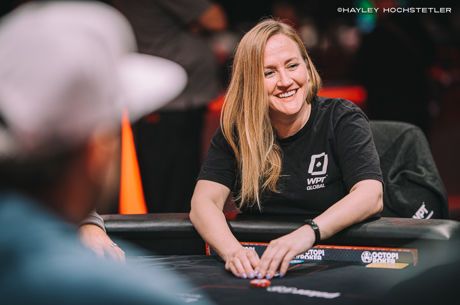All-Time Ring Winner Maurice Hawkins Lobs Constructive Criticism at WSOP Circuit

Table Of Contents
Maurice Hawkins is a polarizing figure in the poker world. He's got fans but he's also got his fair share of haters. You see, he's not one to shy away from speaking his mind, and when the 13-time World Series of Poker Circuit ring winner recently reached out to PokerNews to air some grievances, we listened.
Hawkins is the latest grinder to join the chorus of players frustrated by changes that have affected the game over the years — changes like paying more of the field, the rise of re-entry events, and extended late registration, just to name a few.
"It's the poker scene as a whole, but mainly it's on the WSOP Circuit," Hawkins says with reference to his stomping ground. "They've incorporated unlimited re-entries, and while that may be good to get the numbers up, for the longevity of poker it's terrible. Over a couple of years, a player isn't going to be around for more than 2-3 years max, because he's just never going to turn a profit except here and there."
Too Many Spots Paid
"I think the biggest concern with many people who are playing the Circuit, which is paying 15%, is that you have to get in the top percentile in order to actually min-cash or double your money on the Circuit right now," says Hawkins.
"Basically, you have to get in the top seven percent to double your money. While that may not be problematic to the people that are playing it, the reason the numbers are going down is because the likelihood of doubling your money is slimmer."
"It's just not working for a player to travel for a week when you're not even doubling your money when you min-cash."
Hawkins believes the circumstance is creating a dynamic in which people cannot be equitable playing poker unless they are elite players — in other words, one in which the recreational player will never turn a profit.
"Therefore, we're going to lose that player forever," Hawkins believes. "We need to get the payouts to where it's double the buy-in back to 10 percent. You can take the extra five percent along the bottom end and increase the top a little bit more."
"The allure of poker was when the top prize was life-changing. It's just not working for a player to travel for a week when you're not even doubling your money when you min-cash. With overhead, it's a negative-equitable situation for you. I feel like it needs to be said. I know it probably can't be changed this year, but they need to get back to what made poker beautiful," he says.
Another problem Hawkins sees is allowing players a late registration option too deep in the tournament.
"The other problem is they're allowing people to buy into the 12th and 13th level.... You have people buying in late in tournaments where they didn't have to have the skill it takes to build a stack, to sustain a stack, and to be in the tournament," he says.
This effect of lessening of the game's skill component is an argument against allowing late registration so deep into an event, argues Hawkins.
"The purity of the game is going away because of these late entries... it's causing a dynamic where a poker tournament really isn't about poker, it's more flipping and blackjack, it's gambling."
What's the Solution?

It seems re-entries are a Pandora's Box — once it was opened there was no going back. They simply make venues too much money, and that factor ultimately holds sway over tours and tournament organizers.
"My ideal situation is there should be a maximum of one re-entry," Hawkins says. "It should last for the first six or seven levels."
Some operators, such as the Mid-States Poker Tour, often do employ a single re-entry option, meaning players can re-enter just once per flight. The format has proven popular and the tour has generated strong numbers.
For Hawkins, such a change could help restore poker's purity on the circuit.
"Back in the day you had less chips and it was more emphasis on game theory. When to call a draw, when to raise a draw. When to get it in, when not to get it in. How much a percentage of your stack you're gonna call off? [Are you] going to flip at this position in a tournament because it's early, mid-stage or late?"
"All of that game theory is going out the window with these mass re-buys and max late regs. It's infringing on the purity of the game."
"We're losing a lot of those mid-range players who don't win a lot. They win here or there. They're blowing their bankrolls in two stops."
In his mind, a pure game looks out for both the player and venue, not just the latter.
"We're losing a lot of those mid-range players who don't win a lot. They win here or there. They're blowing their bankrolls in two stops," Hawkins says. "While that's nobody's problem but theirs, allowing them to shoot five, six bullets every tournament they play and have the ideology that's how you play poker, it's going to kill their bankroll and kill the numbers in the long run. I want those people to sustain some sort of lifestyle that they can have some longevity in poker."
Hawkins knows of what he speaks. In his many years grinding the circuit, he has watched many players fall by the wayside.
"The turnover period on players, I used to notice back in the day, I'd say was one circuit year. So you'd see a mid-level grinder come in, have some success, and live off that success for about a year or year-and-a-half. Then he'll realize maybe he's not as profitable as he thought he was."
"Now those guys are coming in firing multiple bullets, and that guy will last two or three stops, which is a quarter of the year. That's why the numbers are going down.

Less Events, More Promotion
Another gripe Hawkins has concerns the number of events going up each year at the WSOP, a trend that isn't likely to slow down any time soon.
"When I started playing poker, to get a bracelet was a big thing," he says. "Now there are so many different ways and events to get bracelets it's been watered down. I don't think there's much allure in it anymore because you can almost buy rings or bracelets."
"If they want their numbers to grow they need to do better publicity at their biggest event."
Last summer there were 90 bracelet events at the WSOP, an all-time high. Meanwhile the WSOP Circuit usually awards a dozen rings at each stop, but with more than 30 stops a year (not including International stops) that's still 360 rings being given out.
Speaking of the WSOP Circuit, Hawkins believes officials are missing a golden opportunity to boost their numbers by failing to promote the Circuit during the summer WSOP.
"I don't feel like the Circuit gets enough love during the WSOP," Hawkins says plainly. "The WSOP-C is a part of the World Series, it's a brand. You have the bracelets, then you have the circuit rings, but at the World Series, they never talk about the Circuit. They should promote the WSOP-C. I don't feel they do it all. If they want their numbers to grow they need to do better publicity at their biggest event. They need to promote the US and International Circuits more."
Hawkins makes it clear that he isn't attacking the WSOP Circuit. He still loves to play and compete as he tries to hold off others in the all-time ring race like Josh Reichard and Valentin Vornicu. Rather he is offering his opinion on what he thinks would help ensure longevity for all mid-majors.
"I don't know if this is going to do anything, but hopefully it changes something," says Hawkins.









